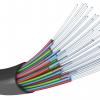Trends like cloud computing, edge computing, and the Internet of Things (IoT) are increasing enterprise connectivity needs. That’s driving a growing number of organizations to investigate dark fiber as an alternative to commercial Internet service.
To find out more about this trend, Network Computing recently spoke with Robert Coenen, vice president of business development for InterOptic, a vendor specializing in data interconnect solutions.
Coenen began by explaining that the term "dark fiber" refers to fiber optic cable that has been laid in the ground but isn't being used. “Whenever somebody buries a fiberoptic cable, most of the cost is in getting that cable into the ground,” explained Coenen. “Something like less than 10 percent of the cost of such a project is actually the fiberoptic cable. So, what they do is bury as many actual fibers as possible.” In many cases, less than half of the actual cables underground are being used, leaving the rest available for companies to lease.

(Image: Billion Photos/Shutterstock)
So why would an enterprise be interested in leasing this dark fiber?
1. It’s all about the money.
The primary reason why organizations begin investigating dark fiber is for the potential cost savings. “If your organization has a lot of data that they need to move around or if you happen to already have access to dark fibers for little or no cost, it will save you a lot of money to bring up your own dark fiber network as opposed to paying thousands or tens of thousands of dollars a month to CenturyLink or Comcast or some other Internet provider,” said Coenen.
2. Dark fiber can also improve latency.
Another benefit of dark fiber is the potential speed. Whenever an organization is using commercial Internet service, traffic gets bounced around to a lot of different points before arriving at its destination. But with dark fiber, organizations can get a straight line from point A to point B, which improves performance.
“For some applications, people really need to get the data really fast from one spot to another,” said Coenen. “And the best way to do that is to set up your own network where you don't have a lot of additional boxes sitting in between.”
3. Dark fiber can provide redundancy.
An even more important benefit for some organizations is the fact that dark fiber can provide physical redundancy for their existing systems. Coenen explained that enterprises often find that even if they are using two different providers as part of their disaster recovery/business continuity (DR/BC) plans, both providers may rely on some of the same physical infrastructure. So in the case of a natural disaster or even something as simple as a construction accident or burst water main, they may lose both their primary connectivity and their backup at the same time.
“If they find that they’re not really able to get good redundancy from their Internet provider, they will run their own fiber links to make sure that they’re getting this type of physical redundancy," he said.
4. Dark fiber does require some expertise.
When asked about the disadvantages of dark fiber, Coenen acknowledged that it does have some drawbacks. The upfront costs can be high. In addition, organizations will need trained personnel. “You need to keep people on staff who know how to manage the system, expand it when it needs to be expanded or repair it to something goes down. So that can be a lot of hidden costs,” he said.
5. You shouldn’t be afraid of dark fiber.
Despite the potential disadvantages, Coenen encourages organizations to investigate whether dark fiber might be right for their needs. “Don’t be afraid to do it,” he said. “People find the idea of dark fiber links or setting up a DWDM connection very intimidating, but lots and lots of other governments and enterprises have done this.”
He advised network architects managers interested in dark fiber to reach out to other colleagues and to transport vendors for tips and training. “There are lots of resources out there,” he added.









